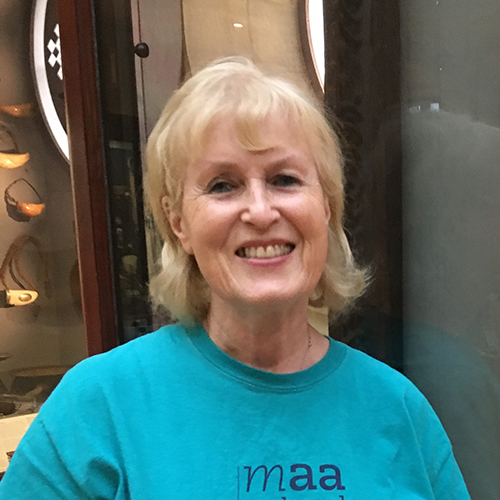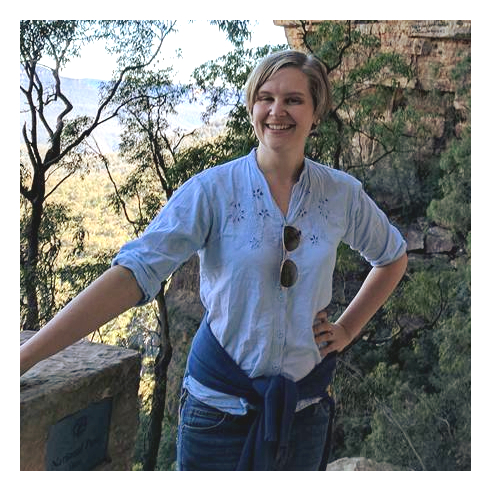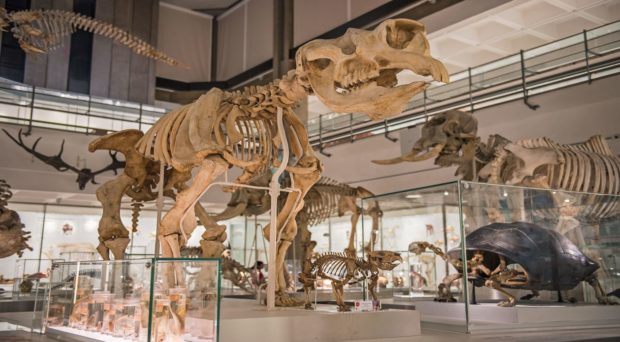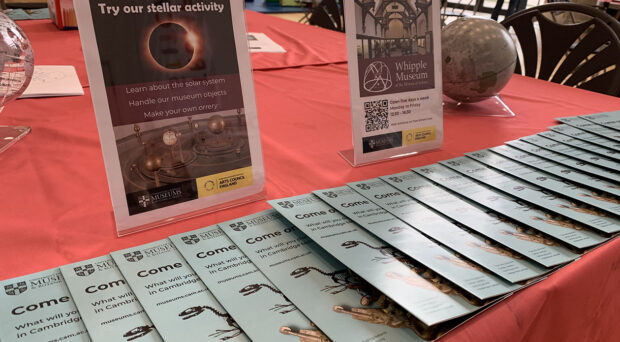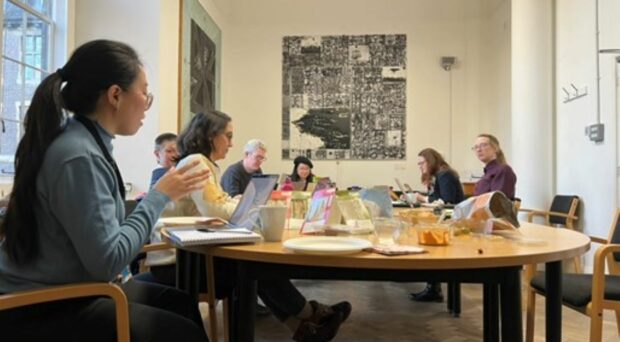As part of a generous Heritage Lottery Fund grant, the Museum of Archaeology and Anthropology (MAA) has recently refurbished its permanent Pacific Island displays.
These displays track two major themes: migration and climate change, and their impact on the culture and lives of Pacific Islander peoples. Welcoming visitors to the displays and answering their questions is a team of Explainer Volunteers. So what’s it like to be Explainer? MAA’s Jenny Williams chats with volunteer Gloria Sayer.
What made you want to volunteer as an Explainer at MAA?
Having decided I wanted to do some volunteering I came across the University of Cambridge Museums’ website. My personal objective for museum volunteering was to learn something myself as part of the experience. To start with they all looked interesting but MAA stood out so I applied to find out more.
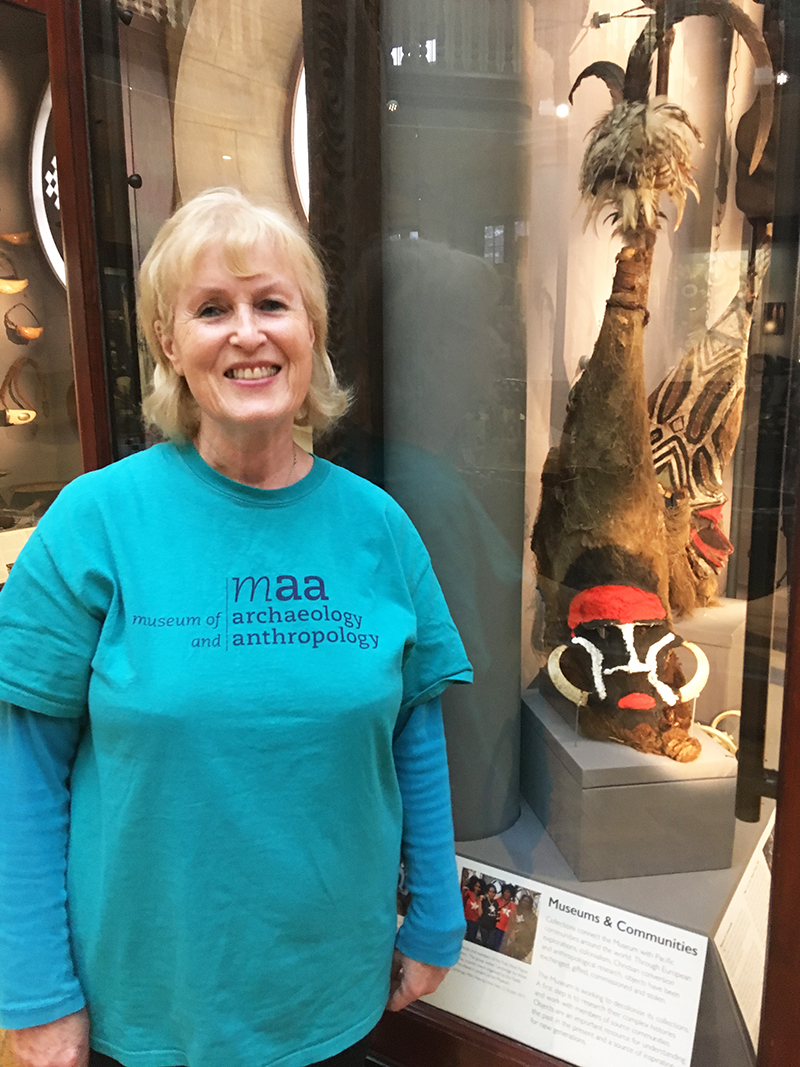
How long have you been volunteering?
At MAA only since October 2018.
Have you always had an interest in museums, or archaeology and anthropology?
I have always liked going to museums. I lived in London as a child so going to different museums was easy. My favourite museum was the Geffrye Museum in Shoreditch, East London which I visited many times with friends and loved filling in the children’s worksheets and finding out how we lived and behaved through the centuries. In recent years my husband and I have travelled to some interesting places visiting sites of past civilisations: Mayan, Greek, Roman and Indian. Though this is not at any level of expertise we feel we gain some understanding of these communities.
What does an Explainer do exactly?
The main objective for the Explainer is to find ways to encourage the visitors to look more closely at the objects on display and gain greater understanding of the items. It’s not to be their guide throughout the visit. I explain the importance of the four cases I am looking after and then give some insights into one or two objects – enough to make them think, “That’s interesting! I didn’t know that. I’d like to see and know more.” I have made up puzzle questions about one object in each case and once I have established that the visitor is happy to talk I will ask if they would like to solve my puzzle. “What do you think this is made of? Can you see anything unusual about this item? What do you think this is used for?” Nobody has refused so far. After they have given an answer, we spend a few minutes discussing the other related objects. I then tell them to let me know if they have any other questions and they continue looking on their own.
Tell us about a typical shift.
My shifts are two hours at a time. I am currently an Explainer for four large cases of items from the Pacific Islands which are presented through two core themes: Environmental and Cultural Sustainability and Exchange and Movement which illustrate the impact on the lives and cultures of the Pacific Islanders over time. On arrival I take a good look to at all four cases, checking to see that nothing has changed since my last shift. I check with the front-of-house team whether any large groups are expected. And then I find some visitors and start explaining. Two hours goes very quickly!
What do you enjoy most about your volunteering?
Meeting such a wide range of people of all ages and from all parts of the world. Also seeing the interesting patterns of visitors who arrive. At weekends it seems to be mainly families. In the week more single visitors, maybe students or older people. The groups that amused me was just before Christmas when granddads and grandchildren were all we saw. All the mums and grandmothers were clearly busy preparing for the festivities.

Which Pacific objects are most people interested in?
The pieces of more recent art such as the ghost net sculptures of the turtle (above) and jelly fish (below) are items that create discussion. Visitors seem to engage with the environmental issues that these items illustrate.
Do you have a favourite Pacific object?
Currently my favourite is a dance head dress, the outside of which is covered in spiders’ webs and topped with chicken feathers. I really enjoy asking the visitors what they think it is made of. Some shudder at the spiders’ webs but a few guess correctly which amazes me.
Is there a surprising, funny or interesting story you can tell from your time at the museum?
Recently a lady was looking closely at the various sized bilum bags which are made all over Papua New Guinea. I asked her if she knew what they were used for. “Yes, and I know how they are made and who by and what it feels like to carry one. I come from Papua New Guinea!” From that moment she became the Explainer, telling me a little about her island life and how she moved to Australia.

What advice would you give to anyone wanting to do a similar role?
If you are a person who is able to start a conversation easily, likes talking to people but knows when to stop, then being an Explainer could be an enjoyable volunteering role for you. But more importantly you will learn too. There are so many exciting objects on display here at MAA, all revealing something about the way communities live, grow and survive. I go home having found out something new every time.
Tell us something surprising about yourself.
Probably not too surprising… I am passionate about drama and community theatre. I act occasionally, direct sometimes and produce regularly. I am just starting my fourth community production to be performed this summer.
Would you like to try your hand at volunteering? Visit the University of Cambridge Museums’ website to find out how you can get involved.

